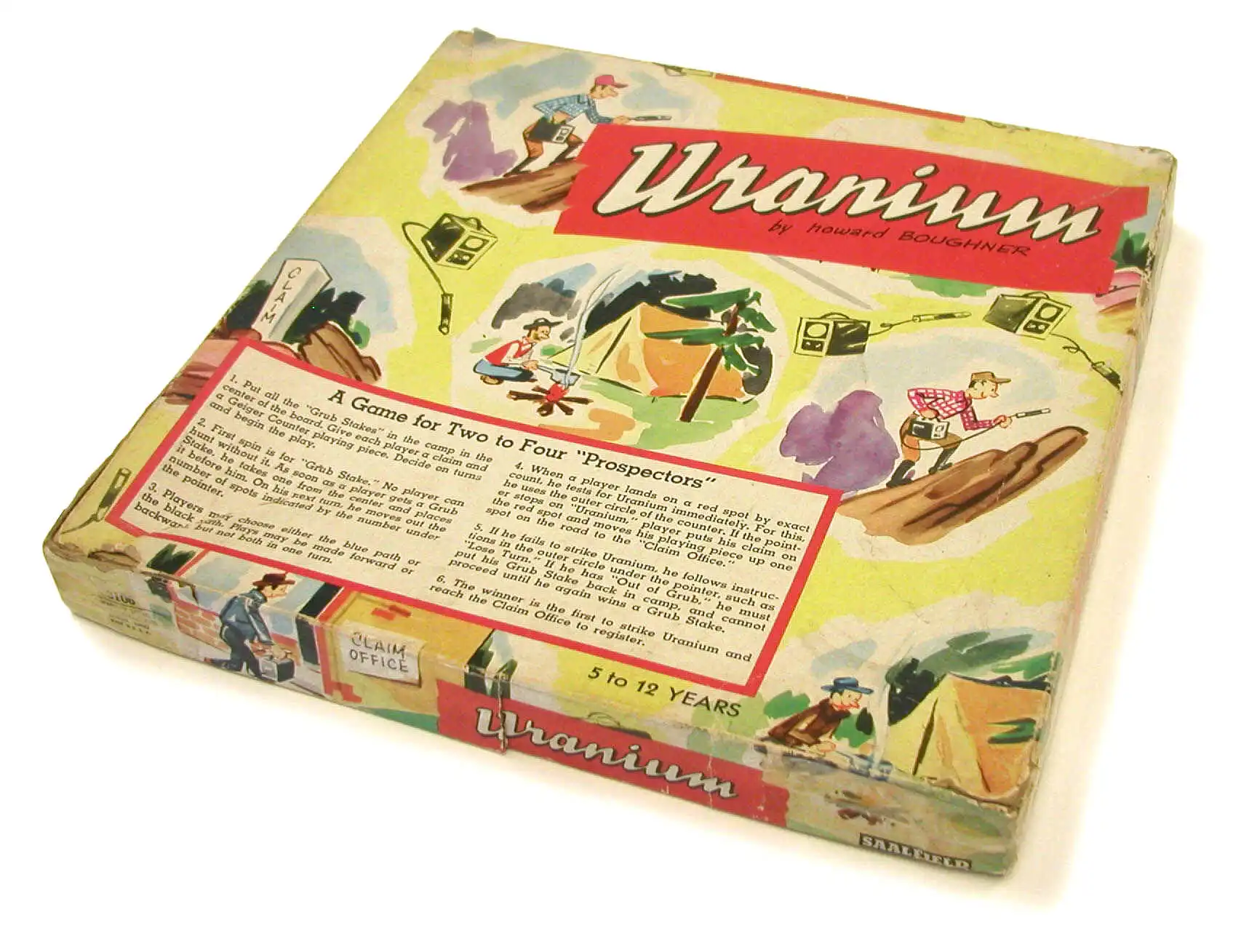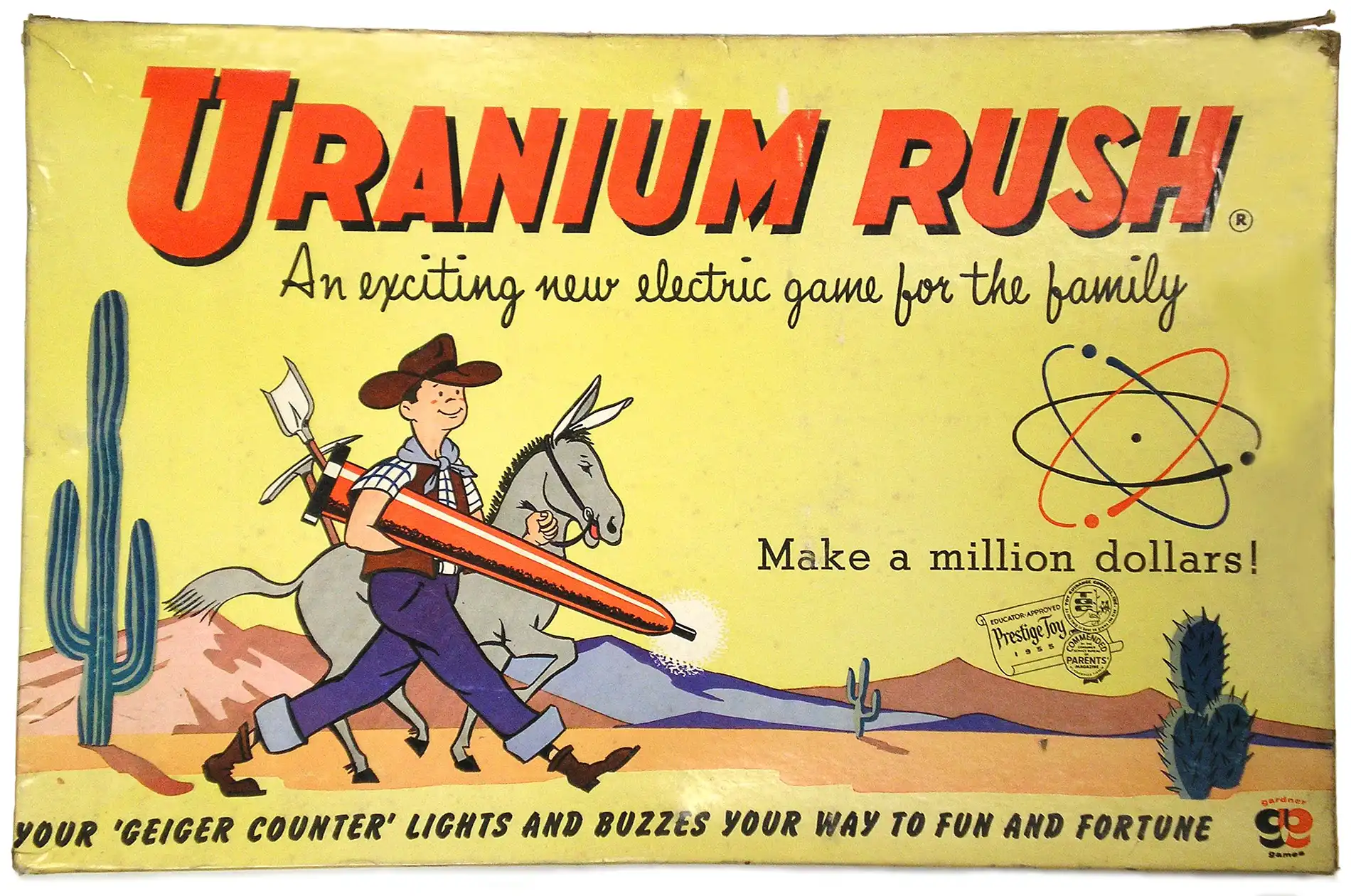As early as the 1950s and continuing for decades more, the theme of radiation could be found just about anywhere you look, from television commercials to billboards. Radiation even found its way into toys and cartoon shows, including board games and later computer games and other items marketed for children. Let’s look at five atomic games located at ORAU’s Museum of Radiation and Radioactivity:
1. Uranium Board Game

During the 1950s and 1960s, the hunt for uranium was a hot topic. At one point during this timeframe, the Atomic Energy Commission (AEC) sponsored the search and advertised fixed rates for uranium ore to go along with bonuses for new discoveries. The idea of hunting for uranium led to the creation of the Uranium board game. The goal of the game was to strike uranium and make it to the claim office before the other players. Once a player landed on the grub stake spot on the board, the race was on to test your uranium by the spin of the wheel. If you were lucky, the pointer would land on uranium, and you were off to the claim office to get your prize!
2. Uranium Rush
Uranium Rush is another thrilling game where players would spin the wheel to see which area of the board they would get to prospect. The options were the purple mountains, the green hill country, or the sandy desert. To stake a claim, a claim marking stake had to be purchased from the government bank for $1,000. If your claim paid off and you had in fact struck uranium, you were awarded $50,000 from the bank. At the end of the game, the player with the most money was deemed the winner. According to Paul Frame, retired ORAU health physicist and the founder of ORAU’s Museum of Radiation and Radioactivity, the price of the game when it was first released in 1955 was right around $3. By 1958, the peak of the uranium boom had passed, and it could be bought for less than a dollar at close-out sales.
3. Uranium Strike

As parents, we look for any way possible to entertain the kids during long road trips in the car. Today, the options are almost endless thanks to mobile technology. Back in the 1950s, this task was much more difficult. One of the car games that were on the market was Uranium Strike. This was one of 15 games in the Escoe Industries' "Fun for the Road" package. Other games included Town and Country Bingo, Rainbow Bingo, and Guided Missiles. Uranium Strike was very simple to play. In turn, each player connected two dots in a horizontal or vertical row, but not a diagonal one. Once a player completed a full square, they staked a claim and got an extra turn. At the end, the winner was the player with the most staked claims. With multiple sheets in the book, this game was sure to keep the kids entertained for hours.
4. Nuclear War
The text on the box for Nuclear War says it’s “a fast-paced comical card game for 2-6 players of all ages.” The goal of this game was simple: to win the nuclear war. To begin the game, each player was given a country to control, and their population was determined by the population cards that were dealt. From there, each player was tasked with using asset cards which were things such as missiles, bombers, and nuclear bombs. Ideally, this would end with your country being the last to survive.
5. Fallout Game

As one of the newest games in the museum collection, Fallout was created for PCs. The plot of the game started with 1,000 people, holed up in an underground shelter, who had no contact with the outside world for some 80 years after a nuclear holocaust. The community's water recycler had failed, and players had to go outside to find a replacement microchip for the recycler. One of the main differences with this game versus the board games of the 50s and 60s is that the PC game contained animated blood and gore, making it less suitable for families with young children. If you are interested in the topic of nuclear fallout, be sure to read our blog on the history of fallout shelters!
Now that we have looked at some of the atomic board games and videos games in the collection, be sure to check out some of the other children’s items at ORAU’s Museum of Radiation and Radioactivity!
